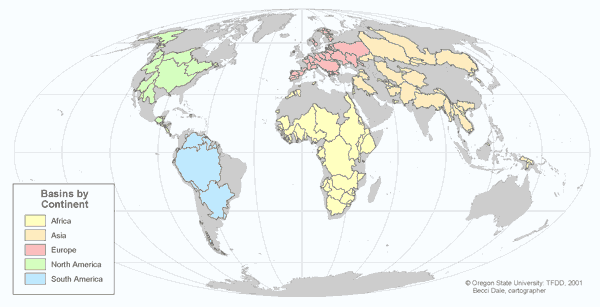Transboundary water: your cut-out-and-keep guide
And so to a veritable treasure chest for scarcity nerds everywhere: the Atlas of International Freshwater Agreements, brought to you by Oregon State University’s Program in Water Conflict Management and Transformation.
Here’s what you need to know. First, there are currently 263 rivers that either cross, or demarcate, international boundaries. Europe has most of them (69), followed by Africa (59), Asia (57), North America (40) and South America (38). Here they are on a handy map (larger version at the link above):
Second, you should know that these international river basins account, according to OSU, for nearly one-half of the earth’s land surface; generate roughly 60% of global freshwater flow; and are home to approximately 40% of the world’s population. A taste of the vulnerabilities that come with this:
A total of 145 countries contribute territory to international basins. 33 nations, including such sizeable countries as Bolivia, Chad, the Democratic Republic of the Congo, Niger, and Zambia, have more than 95% of their territory within the hydrologic boundaries of one or more international basins. Perhaps even more significant is the number of countries that share certain individual basins … The Congo, Niger, Nile, Rhine, and Zambezi are each shared by more than 9 countries while the Amazon, Aral Sea, Ganges-Brahmaputra-Meghna, Jordan, Kura-Araks, La Plata, Lake Chad, Mekong, Neman, Tarim, Tigris-Euphrates-Shatt al Arab, Vistula, and Volga basins each contain territory of at least 5 sovereign nations.
Third, the good news. You might think that the quote above suggests that we’re in for a century of water wars. But it’s worth remembering this: “in the largest quantitative study of water conflict and cooperation, researchers at Oregon State University found that cooperative interactions between riparian states over the past fifty years have outnumbered conflictive interactions by more than two-to-one”. Shared water has to date much more often been a stimulus for cooperation than for competition – a point our buddy Geoff Dabelko also makes consistently. This isn’t a new story, either: “the history of international water treaties dates as far back as 2500 bc, when the two Sumerian city-states of Lagash and Umma crafted an agreement ending a water dispute along the Tigris River”.
But… ah yes, there’s a but. And it is this:
158 of the world’s 263 international basins lack any type of cooperative management framework. Furthermore, of the 106 basins with water institutions, approximately two-thirds have three or more riparian states, yet less than 20 percent of the accompanying agreements are multilateral. Moreover, despite the recent progress noted above, treaties with substantive references to water quality management, monitoring and evaluation, conflict resolution, public participation, and flexible allocation methods, remain in the minority. As a result, most existing international water agreements continue to lack the tools necessary to promote long-term, holistic water management
On top of this, there’s the small matter of climate change to consider – and especially, Cleo Paskal’s observation that “water-sharing agreements, especially those based on a set amount of water, rather than percentage of actual flow, will become problematic as water levels alter dramatically” (Cleo has a new book out, btw). So, lots done – but lots to do.

